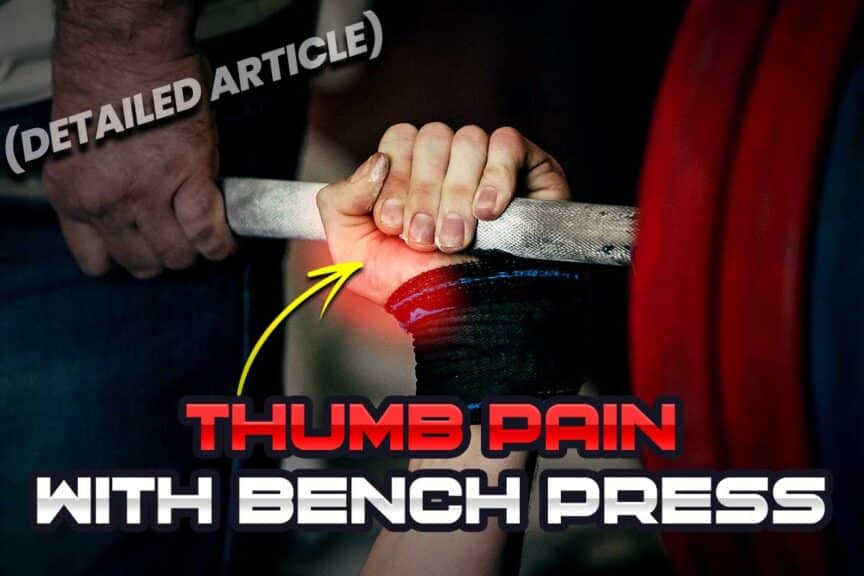Grabbing a heavy barbell and pressing it off your chest is a wonderful feeling; there’s a satisfaction to it that’s hard to explain. Thumb pain, however, is a lousy feeling, especially from grabbing that heavy barbell that you’ll be pressing off your chest. Don’t worry; I’ve got you covered for why this is likely happening and (more importantly) what you can do about it.
Thumb pain during or after bench press can result from arthritis, DeQuervein’s tenosynovitis, median nerve issues, thenar muscle tension, or even carpal issues in the hand. These issues require specific strategies and interventions (discussed in this article).
Thumbs are pretty darn important; when they don’t work properly, it’s hard to do just about anything (including working out). So, I implore you to read through this article to get pointed in the right direction with getting your thumb pain under control.
There’s a lot to unpack here, but doing so will serve you well. After all, how does one tackle a problem when they don’t know the first thing about where to start?
So, let’s get to it!
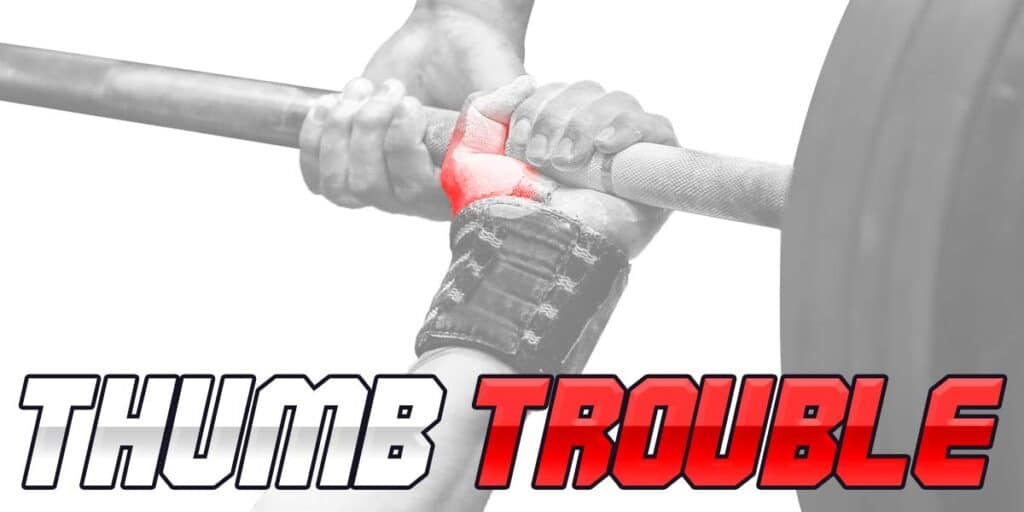
Related content:
Quick heads up: I can’t cover every possible cause of thumb pain with bench pressing within this article. However, I can cover the most commonly seen thumb issues within active populations, which I’ll be doing.
That being said, getting an evaluation from a qualified professional is always best. And please keep in mind that no rule states you can only have one source of thumb pain; oftentimes, a couple (or multiple) factors can cause pain and dysfunction. So, please keep these points in mind as we dive into the specifics!
The basics: thumb & hand anatomy
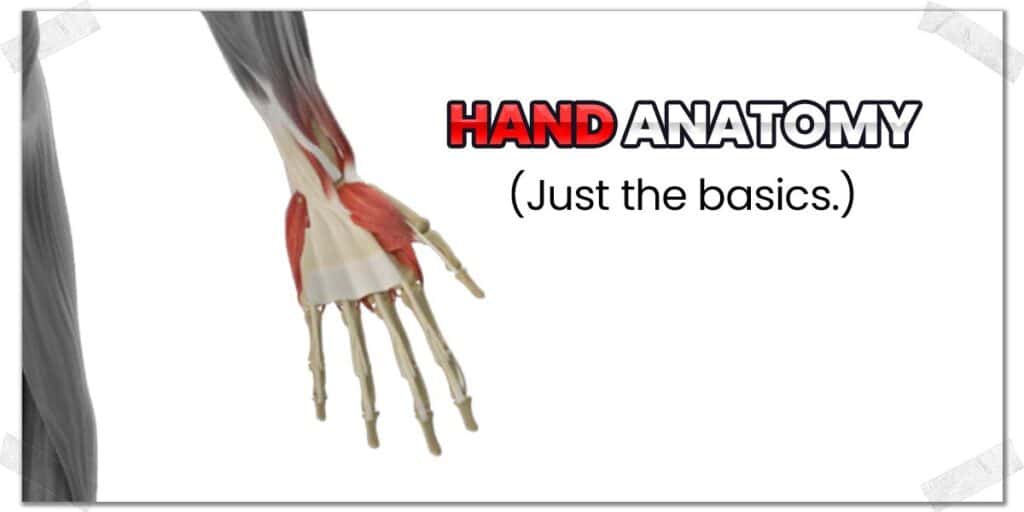
The anatomy of the thumb and hand can get incredibly intricate and complex. Thankfully, we don’t need to get overly complex here; a very basic crash course will do just fine.
Knowing these anatomy basics will help you better understand the causes and solutions for your thumb pain (and help you avoid costly setbacks), so don’t skip this section.
I routinely harp about the above paragraph in my other articles because, as a physical therapist who treats orthopedic conditions all day long, a basic understanding of your pain and condition is truly the foundation from which effective recovery begins.
Orthopedic basics: thumb muscles and tendons
For the thumb muscles, we’ll keep this very simple and divide things into areas where the muscles (or their subsequent tendons) are located. In doing so, we can divide the muscles (or tendons) into those found on the thumb’s front, side, and back.
Here’s what to know:
1. The muscles on the front (palm) of the thumb are collectively known as the thenar muscles (no need to go into specifics of each one here).
2. There are no muscles on the back of the thumb, but there are tendons that run along the back (the muscles themselves are actually located in the forearm). These are the extensor pollicis longus and the extensor pollicis brevis.
3. There are no muscles on the outer side of the thumb, but there is a tendon that anchors onto the base of the thumb bone. This is the tendon of the abductor pollicis brevis.
The names of these muscles and tendons aren’t terribly important. However, I’ve mentioned them due to a very annoying (and somewhat common) thumb condition known as DeQuervain’s tenosynovitis, which is discussed in a following section.
Orthopedic basics: thumb bones and joints
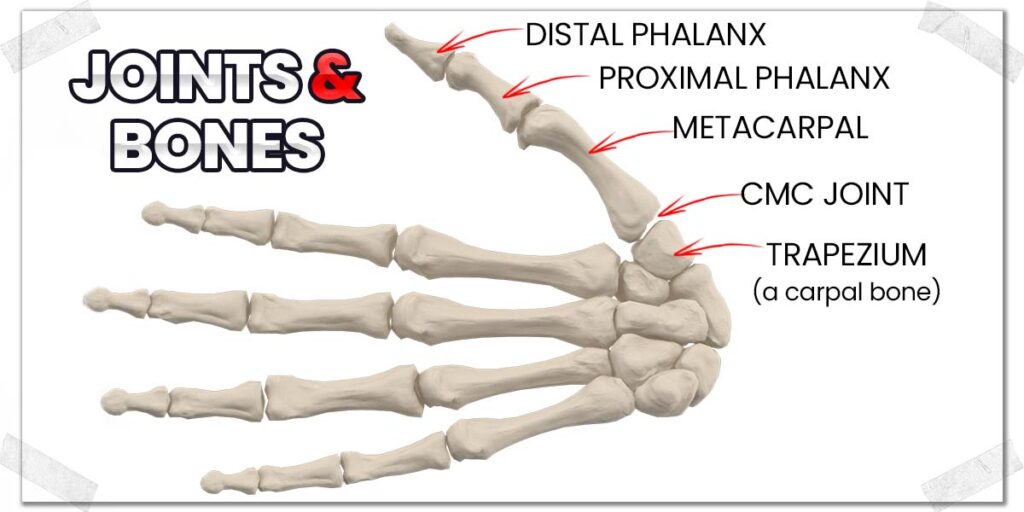
For the thumb, the main bones and joints to be aware of are:
1. The phalanges (there are two for the thumb – the proximal and distal phalanx)
2. The metacarpal bone
3. The trapezium bone (a type of carpal bone)
For the joints, don’t freak out. They have big-sounding names that reference which bone is connecting to the other. We often shorten them to their abbreviated form to make life easier for everyone (including ourselves).
The joints to be aware of here are:
1. The phalangeal joints (distal and proximal)
2. The metacarpophalangeal joint (the MCP joint)
3. The trapeziometacarpal joint (TMC joint)
So, now that you know some basic thumb anatomy, we can dive into some common conditions that can arise with thumb pain and how to address them!
Knowledge: thumb conditions, pain sources, and solutions
Numerous issues can arise in the thumb and hand, leading to all sorts of aches and pains. By no means can I cover them all within a single blog post, but I can cover the most common orthopedic issues of the thumb and hand that wreak havoc on lifters when bench pressing.
So, here’s a rundown on some relatively common issues that will hopefully point you in the right direction for better determining what might be causing your thumb pain when bench pressing.
CMC arthritis of the thumb
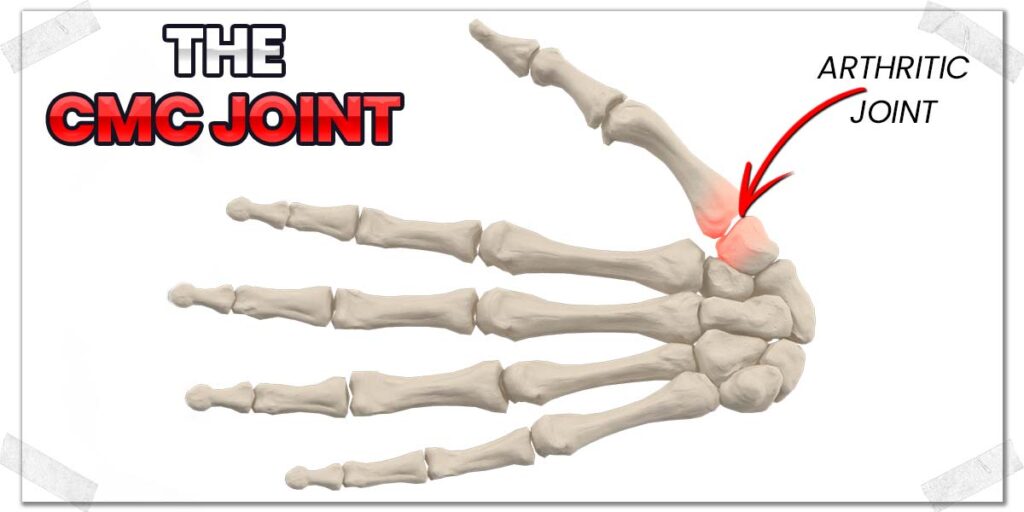
Arthritis of the carpometacarpal joint (CMC joint) of the thumb (also known as Rhizarthrosis) is a painful condition that occurs more often than many individuals might realize.
It is a degenerative condition that involves the deterioration of the joint between the base of the thumb (a metacarpal bone) and the trapezium bone (a carpal bone of the wrist). It is also known as the trapeziometacarpal joint (TMC joint). For the sake of this article, I’ll simply refer to it as the CMC joint.
It tends to present as pain and stiffness along the base of the thumb that occurs with activities such as pinching and grasping objects. The condition becomes more common as we age and affects women more commonly than men.
Treating CMC arthritis: A special note
Dealing with CMC arthritis of the thumb can be tricky. X-rays are typically the first step in the diagnosis of the condition. If a diagnosis is confirmed, you’ll likely want to work with a professional healthcare provider who can help you with:
- Activity modification for your daily life (if it’s affecting more than your bench press).
- Optimizing joint movement and muscle function of the hand and wrist.
Injection-based treatments, such as cortisone injections, into the joint can provide pain relief, but they’re unlikely to provide lasting relief.
You may find it helpful to try using wrist wraps when benching (or performing other lifts), as they can add stability around the wrist, reducing movement of the carpal bones of the wrist, which may reduce discomfort or pain in the arthritic joint.
You may also want to try switching to a different bench press grip (discussed later in this article), as the joint may find a different grip to be more tolerable.
De Quervein’s Tenosynovitis
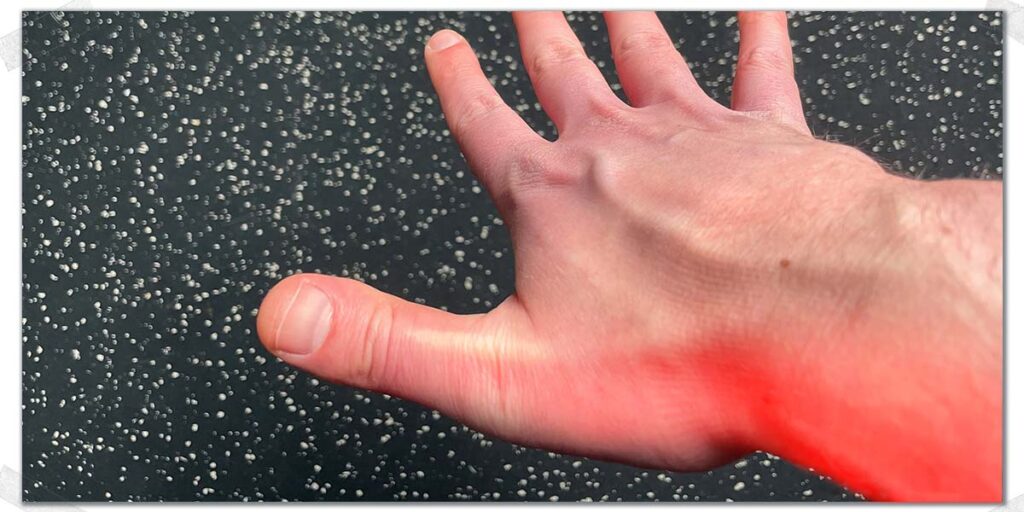
De Quervein’s tenosynovitis is a painful condition affecting the tendon sheath and subsequent tendons that run along the side and back of the thumb at the base. It primarily affects the abductor pollicis longus tendon and the extensor pollicis longus tendon.
It’s most often brought on by overuse (repetitive activities) of the thumb and wrist and affects both men and women.
Pro tip: To test for the presence of this condition, make a fist by wrapping your fingers around your thumb and then pulling your wrist downward – if it reproduces your thumb pain, it’s an indication of De Querviens tenosynovitis. (The test is known as Finklestein’s test.)
Treating tenosynovitis: critical insight
Tenosynovitis can be a bugger to treat; it’s often stubborn to deal with, but outcomes are still favourable when the right steps are taken.
Since the issue is most often brought on by repetitive overuse of the thumb tendons, activity modification is the first step.
This may include foregoing bench press for the time being (only if the strategies below don’t help). Don’t worry; it’d just be temporary. It’s hard (if not impossible) for unhealthy tendons to regain their full health if they constantly endure a movement or activity they can’t tolerate.
Additionally, getting treatment from a qualified healthcare professional can go a long way.
If the condition remains quite stubborn, a steroid injection into the tendon can help relieve any inflammation and pain. Just be aware that steroid injections aren’t typically a cure for irritated tendons; rather, they tend to buy a window for more intense or different types of therapy.
Median nerve issues

The median nerve is one of three primary nerves that run down the arm into the hand. It’s responsible for some of the sensation in your hand and for activating some of your thumb muscles, allowing for its movement.
When it comes to affecting the thumb, the most common issue that can arise with the nerve is carpal tunnel syndrome. It can produce sensations of pain, numbness, and tingling in the thumb and index finger (though other fingers can also be symptomatic).
Carpal tunnel and other median nerve issues that affect the thumb can be tricky to deal with. As such, it’s worth getting an evaluation and treatment from a qualified professional to help find interventions and strategies that make a difference in your thumb condition. Leaving nerve issues to their own devices can lead to a worsening of symptoms, so be sure to get things checked out.
Thenar muscle tension
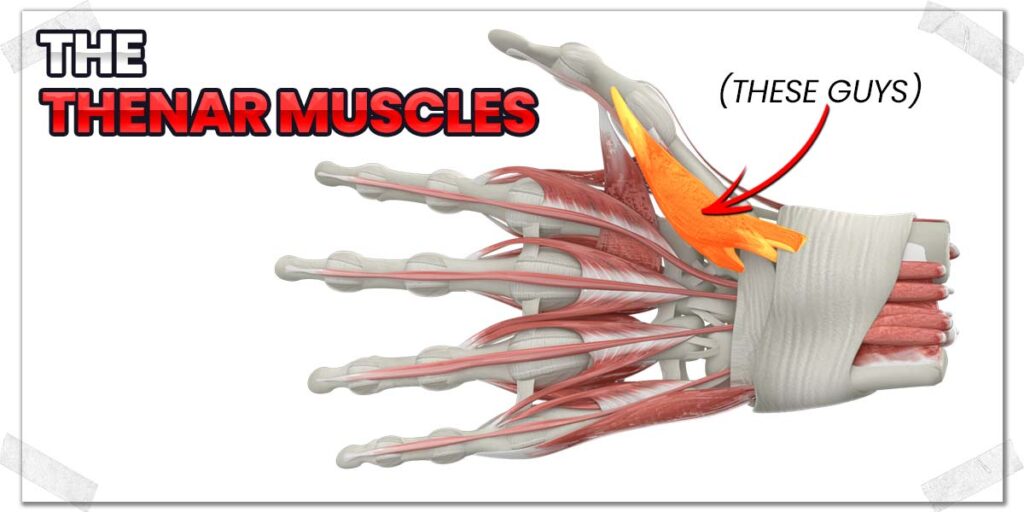
The thenar muscles are a group of muscles that form the meaty part of your thumb on the palmar side of your hand. The specific names of each of these muscles are not important for this article.
What is important, rather, is knowing that these muscles are subject to becoming tight and sore (particularly from overuse), just as with any other skeletal muscle in the body.
Tight, overworked muscles can become extra sensitive when contracting and when pressure is applied to them – two particular actions that take place when grabbing and holding the barbell during the bench press.
Solutions for thenar muscle tension
If it’s simply a case of your thenar muscles being a bit too tight (making them sore), there are a few rather straightforward interventions you can try (if you’re looking to take care of the issue on your own).
Heating and massaging the muscles are initial steps to try. Sore, overworked muscles tend to enjoy heat and massage, both of which work to enhance blood flow into the region and relax the muscles. How you want to specifically go about this is up to you, so take some time to determine what works best for you.
Generally speaking, heating the muscles (using a heat pack of some kind) for ten or twenty minutes and then immediately following it up with self-massage for around five or ten minutes should be a nice therapeutic dosage.
Before the bench: Pre-bench press thumb warmup strategies
Regardless of the specific issue, coming up with an effective warmup strategy for your thumb and wrist is a smart move to make (assuming you want to keep on benching). The following points are considerations you can make for warming up your wrist and thumb before a bench session, which can go a long way in keeping your thumb happy and the weight heavy.
- If possible, heat the area for five or ten minutes. It will decrease fluid viscosity in and around the joints and tendons of the thumb, which your thumb will appreciate from a pain-reducing perspective.
- If you’re confident your thumb pain is the result of muscle or tendon soreness, performing some soft tissue work to your thenar muscles and forearm muscles (on the backside of your forearm) using a lacrosse ball or similar object can make a notable difference in how your thumb feels afterwards
Remember: Some of the thumb muscles actually originate in the forearm, so devoting some soft tissue work to your forearms can help keep your thumb happy.
- You can consider tapping your thumb using athletic tape (specifics are beyond this article). If you feel your thumb could benefit from being taped up in a way that restricts its movement (which can alleviate pain), you can give this a try. A quick google or YouTube search should yield some helpful walkthroughs for how to do this.
Using wrist wraps: when and when not to use
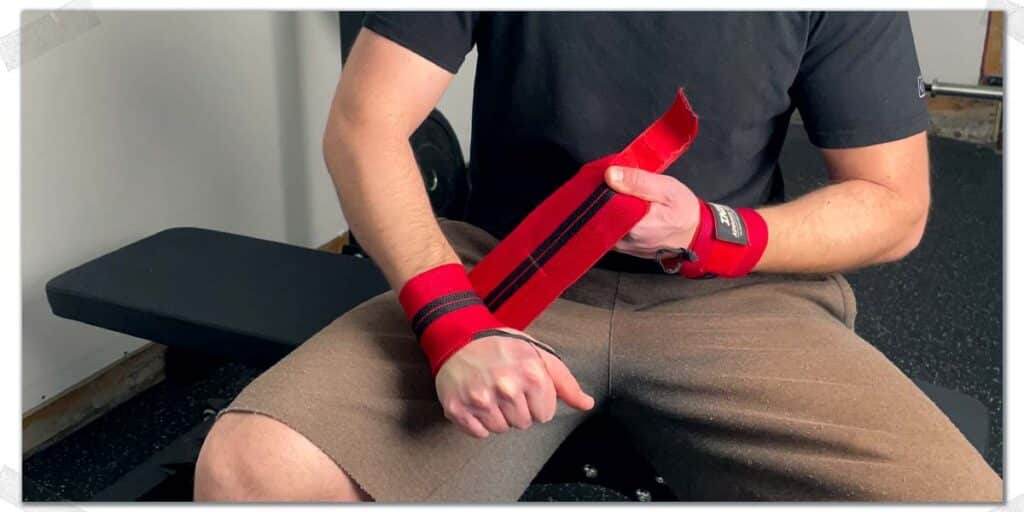
Wrist wraps are thick elastic bands lifters often use during the bench press. They are wrapped very tightly around the wrist as a means to increase stiffness and control of the wrist when bench pressing heavy weight.
Wrist wraps can be very helpful for reducing or eliminating thumb pain during the bench press, but they may increase pain or discomfort for certain thumb issues, such as De Quervein’s tenosynovitis. As such, if wraps are making your thumb pain worse, you’ll want to avoid using them.
Potential indications for using wrist wraps with thumb pain
While this is by no means an exhaustive list, here are some general scenarios in which it may be beneficial to use wrist wraps when benching:
- You have a history of wrist injuries that have left either your wrist or thumb hypermobile (meaning the wrist joints — notably the trapeziocarpal joint — is too loose or unstable).
- You find that compression around your wrist or base of your thumb eases your pain or takes it away completely.
Contraindications for using wrist wraps with thumb pain
As with the previous section, this list is by no means exhaustive for reasons to consider avoiding wearing wrist wraps for bench press. What follows below are simply the more common reasons why it may not be worth wrapping your wrist to save your thumb when benching:
- The process of applying the wraps makes your thumb pain worse.
- The wraps make your thumb feel worse when grabbing the barbell or during the bench press itself.
- You have De Quervein’s tenosynovitis.
Remember: If wrist wraps cause pain or discomfort in your wrist or thumb, you could consider taping your thumb instead. This wouldn’t be a permanent strategy but rather one that helps you tolerate benching as you work on getting the underlying issue resolved.
Changing it up: Grip variations & wrist positions
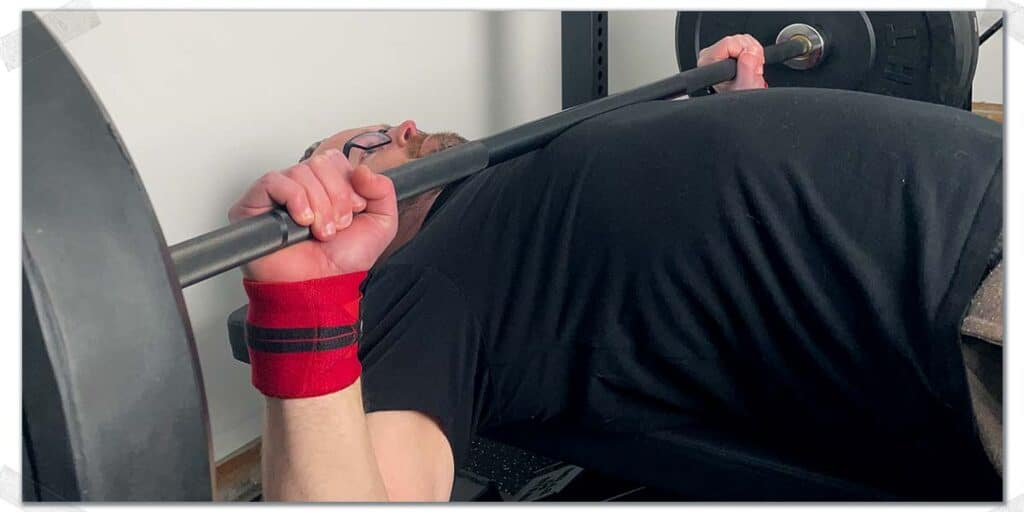
While there might be an optimal grip style and technique when benching for maximal weight, there’s no universal best grip or hand position when bench pressing with thumb pain; pain can respond differently (for better or worse) with various types of bench press grips based on the lifter’s underlying issue.
As such, there will be room to experiment with the following grips and techniques. What works ideally for one lifter’s thumb might not work for you. I’ve seen lifters over the years who have to modify their bench press grips in all sorts of ways to reduce or eliminate their thumb pain.
There are two main grips to consider with the barbell bench press:
1. The closed grip.
2. The open grip (often called a false grip or suicide grip).
Let’s quickly look at the factors involved with each grip type and why it may or may not influence thumb pain (for better or worse).
The closed grip: what to know
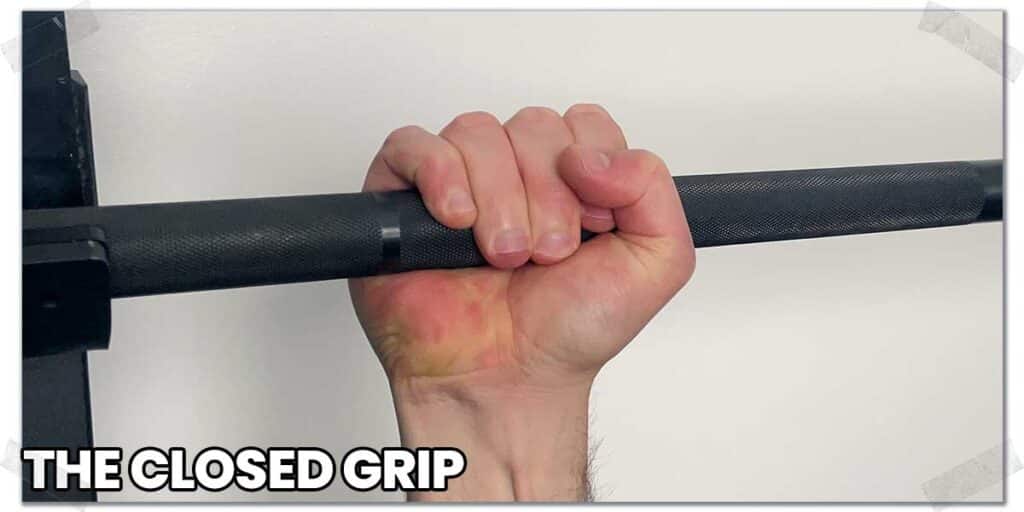
When the thumb wraps around the bar, a tighter grip can be had on the bar. This allows for greater control of the barbell during the press and even greater muscle activation of the muscles in the arm due to increased neural activation.
So, naturally, this is quite ideal, but there are a few potential issues to note:
- A tight, closed grip might irritate an arthritic CMC joint due to the increased pressure the joint experiences from squeezing the bar.
- If you have sore or painful thenar muscles, a tight grip might add to extra discomfort (or pain) of these muscles due to the intense contraction they undergo with the closed grip, particularly when squeezing the bar.
Again, nothing is universal here; you’ll just need to keep those bullet points in mind if you’re using the closed grip. If the closed grip feels better to use, awesome. If it feels worse, try the open grip (discussed below).
The open grip: what to know
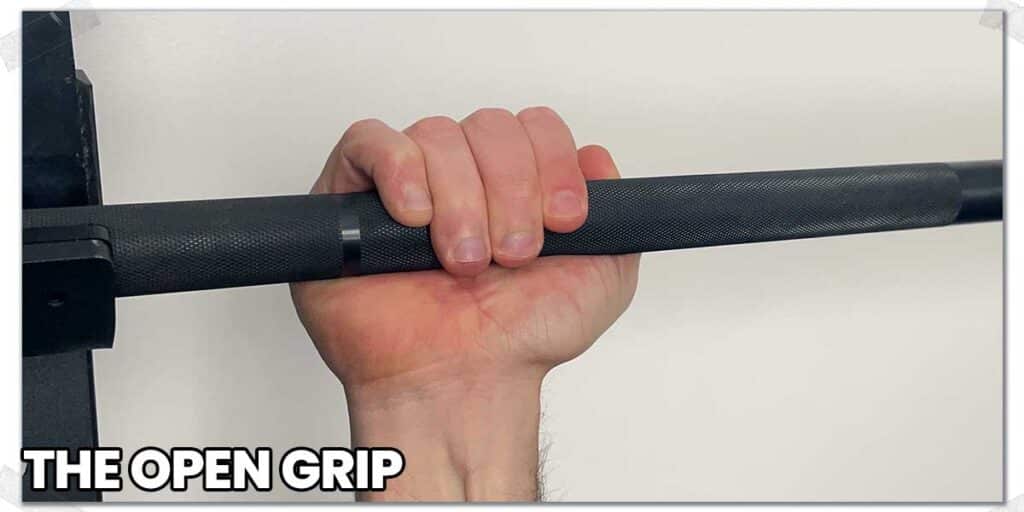
The open/false/suicide grip is sometimes shunned by certain lifters, but it may just be what allows you to keep on bench pressing while you work to get to the bottom of your thumb issue (and plenty of advanced lifters still train with this grip).
The benefits of the open grip are that it might reduce thenar muscle pain since these muscles won’t be contracting aggressively during the bench press (they tend to rest a bit more since the bar isn’t being squeezed).
One of the potential drawbacks here is that the thumb is kept in a position that may further irritate the CMC joint. It’s not a guarantee, mind you, but something to be aware of.
As with the closed grip, your thumb may respond favourably to this grip or not so favourably. As such, you’ll have to find out for yourself.
Grip width considerations
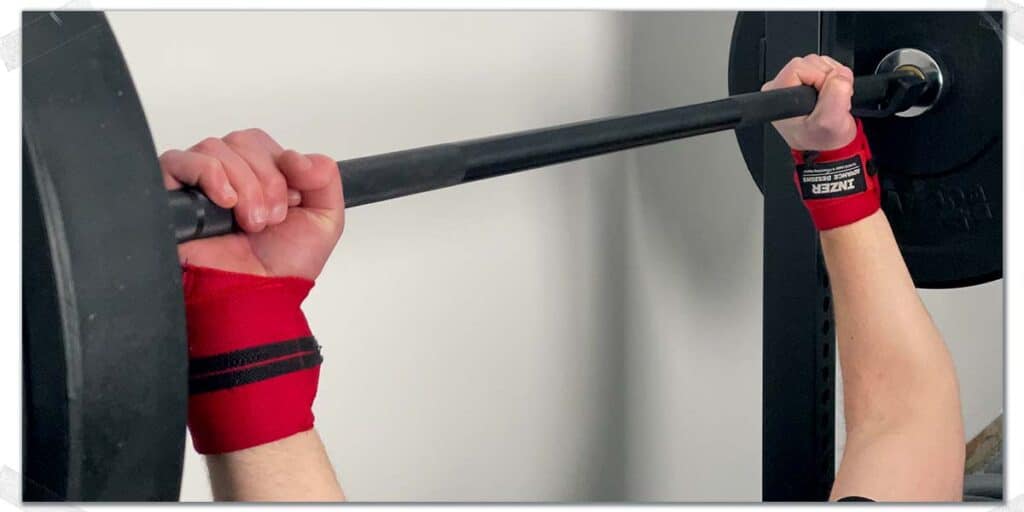
The additional factor that you’ll likely want to consider is your grip width on the bar. This will likely only have a small influence on your pain (if any at all), but it’s still worth quickly mentioning for you to consider.
Making the switch: using dumbbells
One final strategy that may be worth trying, should you need it, would be to try foregoing the barbell for dumbbells. It may not make a difference, but it’s worth a shot.
Here’s why: In theory, it could be that allowing your wrists to move independently (via dumbbells) may reduce the discomfort that can arise by the thumb (connected to the wrist) being wrapped around a bar that keeps the wrist in a strict position.
The barbell confines the wrist (and, therefore, the thumb) to a specific position. Dumbbells, on the other hand, allow your wrists to freely rotate, meaning you can perform the press with a semi-neutral or neutral wrist position.
So, consider giving it a shot if need be. It might not help, but I want to give you as many options and strategies as possible for this article.
Related content:
Final thoughts
There can be multiple causes of thumb pain, any of which can become more noticeable when holding a barbell and bench pressing. Don’t ignore thumb pain and try to blindly push through it – that likely won’t get you very far.
Instead, take the time and effort required to get a diagnosis and then implement any of the strategies in this article that reduce (or hopefully eliminate) any pain or discomfort.
Be a smart lifter and put in the work required to get your thumb feeling healthy again. The result will be less pain and more bench pressing, making you a healthier and stronger lifter.
Frequently Asked Questions
I’ve included some answers to some common questions that lifters have when experiencing thumb pain during the bench press. Some of these answers are elaborated on much more extensively in the above article, but a quick summary of any of these answers is provided below.

Hi! I’m Jim Wittstrom, PT, DPT, CSCS, Pn1.
I am a physical therapist who is passionate about all things pertaining to strength & conditioning, human movement, injury prevention and rehabilitation. I created StrengthResurgence.com in order to help others become stronger and healthier. I also love helping aspiring students and therapists fulfill their dreams of becoming successful in school and within their clinical PT practice. Thanks for checking out my site!

